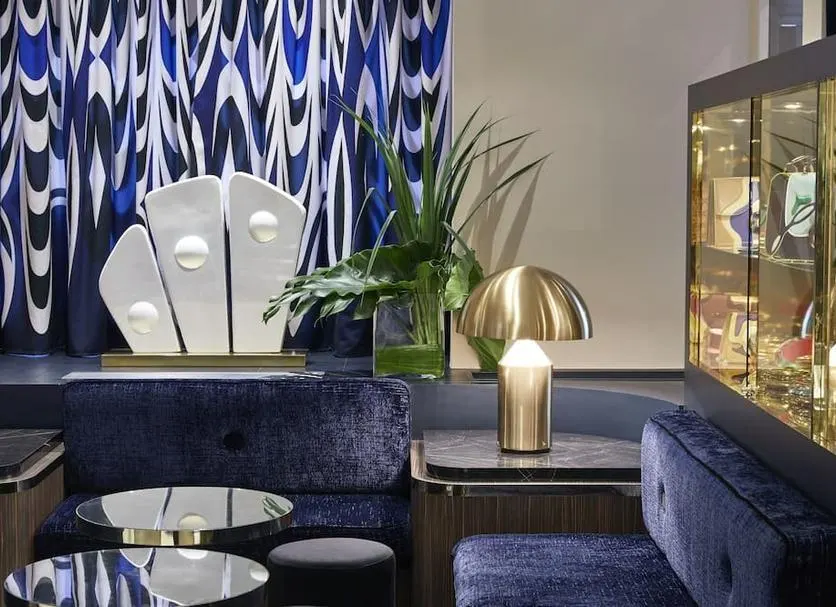Copyright Forbes

Once home to the first edition of Maupassant’s Bel-Ami, the space is an interpretation of contemporary style shaped by a literary sensibility Few neighborhoods in Paris are as instantly recognizable as Saint-Germain-des-Prés. Located in the 6th arrondissement on the Left Bank, the area is known for its mix of history, culture, and commerce. In the 19th century, it became a gathering place for writers, philosophers, and artists who helped define an age of modern thought. Today, it remains one of Paris’ most desirable districts, filled with cafés, galleries, and boutique hotels that attract visitors seeking both culture and convenience. One property worth the visit is Hôtel Bel Ami. The building once housed a 19th-century printing house that produced the first edition of Guy de Maupassant’s novel Bel-Ami in 1885. The book, now considered a classic of French literature, explores ambition and social mobility through the story of Georges Duroy, an ambitious journalist who climbs Paris’s social ladder by manipulating those around him. Maupassant’s themes of power and perception reflected the realities of Parisian society at the time, making it an incisive portrait of the city’s elite. Today, the hotel nods to its origins and to the neighborhood’s long relationship with literature and art. Interior Design and Layout The design of Hôtel Bel Ami favors modern efficiency and clean lines. The lobby feels open and bright, with large windows overlooking Rue Saint-Benoît. Walls in light neutral tones are paired with walnut paneling and stone floors. Seating clusters of low armchairs in moss green and navy surround small round tables finished in brushed steel. A mirrored infinity sculpture made of polished chrome anchors the space, immediately drawing the eye on arrival. Built-in bookshelves line the perimeter, stocked with a rotating collection of French and international titles. Guests often read or settle in with a laptop while ordering coffee or drinks from the adjacent bar. The atmosphere is quiet and comfortable, equally suited to conversation or concentrated focus. MORE FOR YOU Bel Ami Bar and Café The bar carries through the interior’s mix of dark wood, green velvet, and subtle metallic finishes, offering ample lounge and counter seating. Down the hall, the café and breakfast room use lighter materials: oak floors, cream textiles, and brass accents. Breakfast centers on French staples (baguettes, pastries, and local jams) paired with fresh juice and espresso. For lunch and dinner, the kitchen keeps things straightforward with compact seasonal menus built around ingredients from Île-de-France. Seafood, local produce, and classic desserts make up most offerings. The property describes its culinary program as bistronomic: refined cooking in a relaxed setting. The beverage selection leans toward French wine and spirits, complemented by a concise list of traditional cocktails. The emphasis is consistency and familiarity rather than experimentation. Inside the Rooms and Suites At Hôtel Bel Ami, each room follows the same design philosophy as the rest of the property. Streamlined layouts, balanced proportions, and a muted scheme of warm neutrals, soft blues, and natural wood define the hotel’s aesthetic. Standard rooms are efficient yet thoughtfully equipped. Plenty of storage, blackout drapes, and upholstered linen headboards maintain a classic look. Lighting is adjustable, with USB ports integrated into the bedside tables. Bathrooms feature white marble, gleaming fixtures, and walk-in rainfall showers that add a touch of refinement. Suites, redesigned by Parisian architect Pascal Allaman, introduce more space and light. At roughly 430 square feet (40 square meters), they include a small sitting area, generous windows, and a richer color range. Olive and slate tones replace the lighter neutrals of the standard rooms. Subtle mid-century references in the artwork and furnishings connect Saint-Germain-des-Prés’ modern design culture with its artistic past. The two-bedroom apartments, also designed by Allaman, expand that layout with a full living area and two separate bedrooms, ideal for families or extended stays. Finishes remain consistent throughout: pale oak floors, Dedar textiles, and continued use of marble in the bathrooms. The progression from standard rooms to apartments feels cohesive, with each space building naturally on the next. At the top of the house sits the Terrace Apartment, marked by an A. Terrasse plaque on its door. It’s the hotel’s most popular stay and one of the few rooms in the district with a private outdoor terrace. The patio accommodates both dining and lounging, furnished with neutral outdoor seating and framed by greenery for privacy. Inside, sliding glass doors divide the bedroom and living area, while a mix of oak, taupe wall panels, and satin-metal details keeps the space bright and contemporary. Across all categories, technology is integrated seamlessly: smart lighting, strong Wi-Fi, and discreet soundproofing maintain a calm, connected environment. Spa and Fitness The wellness program at Hôtel Bel Ami is now led in partnership with Calma Paris, a French wellness brand that empahsizes mindfulness and recovery through natural, sensory treatments. The spa occupies an intimate space on the lower level with two treatment rooms, a steam area, and an adjoining fitness studio equipped with Technogym machines and free weights. The design continues the hotel’s visual language: pale stone walls, matte finishes, and indirect lighting that create a sense of peace. Signature offerings include Calma’s restorative facial, which uses trace minerals and marine actives to restore hydration, and a full-body massage designed to ease tension. Technology and Sustainability Hôtel Bel Ami is integrating technology to better reduce paper waste. Guests receive a QR code that provides digital access to international newspapers and magazines, allowing them to stay connected to publications from their home countries without relying on print editions. The system supports the hotel’s environmental policy to minimize paper use and aligns with Paris’ broader sustainability goals for hospitality. The hotel also extends its publishing heritage through literacy initiatives, donating books to schools and libraries in regions where reading materials remain scarce, including parts of West Africa, South America, and Southeast Asia. These efforts are coordinated through European literacy organizations that manage international distribution. Guest stays help fund the logistics, making each visit a direct contribution to global literacy. Saint-Germain-des-Prés: Then and Now The neighborhood takes its name from the Abbey of Saint-Germain-des-Prés, founded in the 6th century and considered the oldest church in Paris. By the 1800s, the area had become a hub for the city’s intellectual life. Writers like Sartre and de Beauvoir, along with artists and musicians, frequented its cafés and bookshops, making the district synonymous with creativity and thought leadership. Today, Saint-Germain-des-Prés maintains that identity, though its expression has evolved. Fixtures like Café de Flore and Les Deux Magots remain, joined by luxury boutiques, art galleries, and contemporary hotels. Streets such as Rue Jacob and Rue Bonaparte are lined with bookstores, interior design ateliers, and small studios. The Louvre and the Musée d’Orsay are both a short distance away, while the Luxembourg Gardens sit just to the south, affording travelers convenience without the congestion of the city. Hôtel Bel Ami fits naturally into that continuum, informed by the area’s literary past yet operating within the demands of modern hospitality. Like the neighborhood around it, the establishment has naturally adapted without losing its character.



